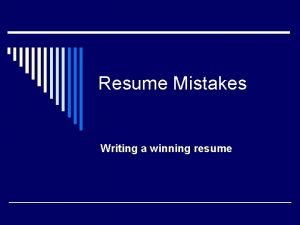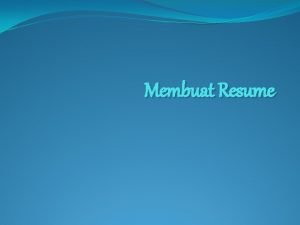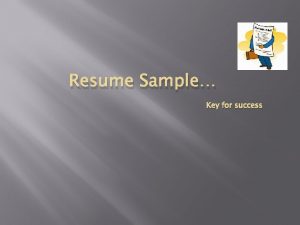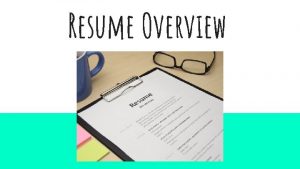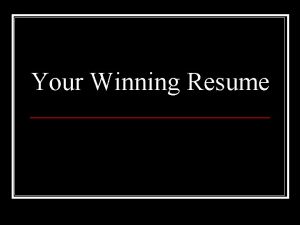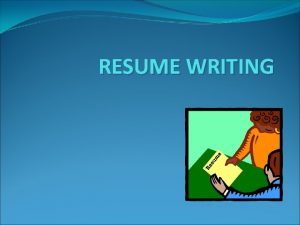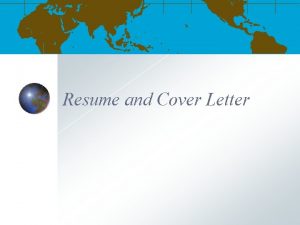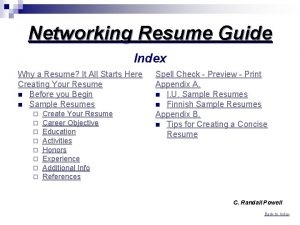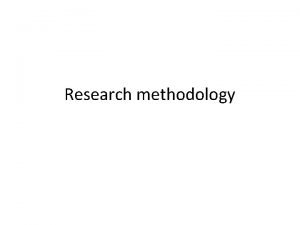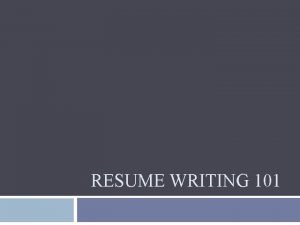RESUME The How to Guide Resume What is




















- Slides: 20

RESUME The How to Guide Resume

What is a resume • A resume is a document used by job seekers to help provide a summary of their skills, abilities, and accomplishments. • To introduce yourself to a potential employer

Why do I need a Resume • Employers use resumes to quickly screen potential applicants, selecting only the individuals they feel are right for the position.

Section 1: How to Build a Resume Font • Use SERIF FONTS like Times new roman*, Bodoni MT, and Bookman old style. • SAN-SERIF FONTS are also acceptable, like Arial, Verdana, and Century gothic. • NEVER use COMIC SANS

Resume Layout and formatting • Keep it clear and clean!! • Margin: ½ to 1 inch each side • Font size: between 10 and 12 (except your name) • Spacing: single spacing with a blank line between each section of content

Resume categories 1. Header: Personal information (name, phone number, e-mail address) 2. Qualifications summary: A recap of your skills and experience that highlight your value to a potential employer. 3. Education: School information and awards. 4. Experience/Qualifications: Work history (who you worked for, what you did, and how long you did it. )

Resume categories 5. Skills and abilities: Skills that relate to the position you apply for and make you the perfect candidate. 6. References: Provide a list apart if required. 7. Interests: Only if they are related to the job you are applying for.

Length and legibility • A resume should be one-page long. Maximum 2 pages • However, don’t sacrifice legibility to fit all your information in one page. • Be clear. Be brief. Be professional.

Section 2: how to write a resume • Tailoring your resume • Make your resume absolutely perfect for the job you’re applying for. • All jobs are different. What works for one may not be appropriate for the other. Don’t send the exact same resume

Use action verbs and power verbs • They help catch the hiring manager’s eye and give you an edge. Make you stand out. • When listing skills and accomplishments, try using the most impressive words you can think of.

Dynamic action verbs EX. • Instead of led (lead) : Controlled, coordinated, executed. • Instead of developed or created: Administered, designed, engineered, established.

EXAMPLE

Resume checklist-- your resume is: 1. tailored Goals, skills, experiences, etc. are clear 2. Aesthetically pleasing Clean, NO ERROR! 3. Complete All categories are included 4. Accurate Everything can be verified. DO NO LIE! 5. Focused No confusion 6. Short

Resume checklist-- your resume is: 7. Relevant 8. Professional No personal statements or detail about every job you’ve ever had since birth to present 9. Current Dates are correct and you include the most up to date information (phone number and e-mail) 10. YOURS!! (Not copied from Internet)

DON’T … • Use title “resume” • Use unnecessary words. Short and sweet! • Include salary information • List why you left previous jobs • Include personal information such as age, race, sexual orientation and hobbies • Include a photo of yourself • DO: DOUBLE-CHECK FOR ERRORS! THEN, CHECK AGAIN!!



References and amazing links – http: //theinterviewguys. com/how-to-make-a-resume-101/ – https: //www. pongoresume. com/articles/56/good-and-badresumes-want-to-see-the-difference-. cfm – www. vault. com/resumes • List of professional skills – http: //jobsearch. about. com/od/list/fl/list-of-skills-resume. htm – http: //www. businessnewsdaily. com/2135 -job-skillsresume. html

List of jobs for your resume 1. 2. 3. 4. 5. 6. 7. 8. 9. 10. 11. Babysitter Sports coach Bellhop Berry picker Cashier Clerk in a videostore Dance instructor Dishwasher Dog walker Gardener Gas station attendant 12. 13. 14. 15. 16. 17. 18. 19. 20. Lawn mower Lifeguard Painter Paperboy Pet groomer Salesperson Snow remover Waiter/waitress Wrapper Or any other job that you might think of as long as you run it by me first

Resume rubric /12 1. The resume demonstrates appropriate language use regarding verbs and sentence structure. 1 2. The resume demonstrates appropriate formatting, is organized, clear, and attractive in its layout. 1 2 3 3. The resume represents a complete list of the student’s qualifications and education description. 1 2 3 4. The resume represents a complete list of the student’s experience and work history. 1 2 3 1=does not meet expectations 2=meets expectations 3=exceeds expectations 2 3
 Sự nuôi và dạy con của hổ
Sự nuôi và dạy con của hổ điện thế nghỉ
điện thế nghỉ Các châu lục và đại dương trên thế giới
Các châu lục và đại dương trên thế giới Dạng đột biến một nhiễm là
Dạng đột biến một nhiễm là Biện pháp chống mỏi cơ
Biện pháp chống mỏi cơ Bổ thể
Bổ thể Phép trừ bù
Phép trừ bù Thiếu nhi thế giới liên hoan
Thiếu nhi thế giới liên hoan Vẽ hình chiếu vuông góc của vật thể sau
Vẽ hình chiếu vuông góc của vật thể sau Chúa yêu trần thế
Chúa yêu trần thế Một số thể thơ truyền thống
Một số thể thơ truyền thống Sơ đồ cơ thể người
Sơ đồ cơ thể người Tư thế ngồi viết
Tư thế ngồi viết Công thức tính thế năng
Công thức tính thế năng Thế nào là số nguyên tố
Thế nào là số nguyên tố đặc điểm cơ thể của người tối cổ
đặc điểm cơ thể của người tối cổ Tỉ lệ cơ thể trẻ em
Tỉ lệ cơ thể trẻ em Các châu lục và đại dương trên thế giới
Các châu lục và đại dương trên thế giới Phản ứng thế ankan
Phản ứng thế ankan ưu thế lai là gì
ưu thế lai là gì Các môn thể thao bắt đầu bằng tiếng đua
Các môn thể thao bắt đầu bằng tiếng đua





















